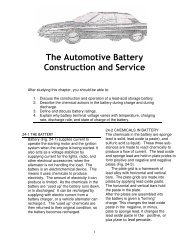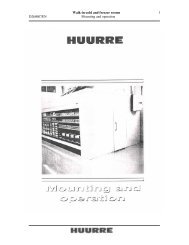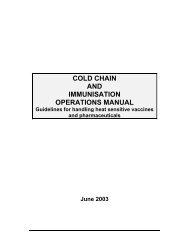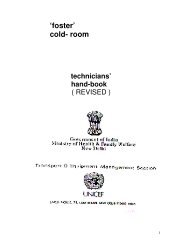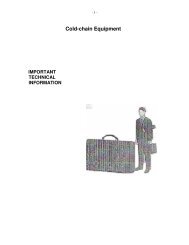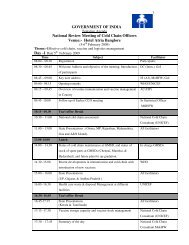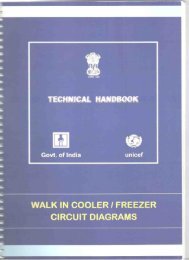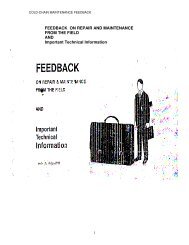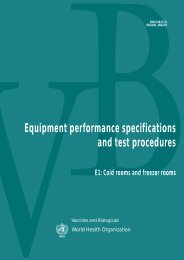Report on Cold Chain Assessment of Jharkhand - 2005 - Nccvmtc.org
Report on Cold Chain Assessment of Jharkhand - 2005 - Nccvmtc.org
Report on Cold Chain Assessment of Jharkhand - 2005 - Nccvmtc.org
- No tags were found...
You also want an ePaper? Increase the reach of your titles
YUMPU automatically turns print PDFs into web optimized ePapers that Google loves.
<strong>Cold</strong> <strong>Chain</strong> <strong>Assessment</strong> in <strong>Jharkhand</strong>EPI was initiated in India in 1978, and in 1985-86 the Universal Immunizati<strong>on</strong> Programmewas launched. To ensure programme implementati<strong>on</strong>, all PHCs in the state were equippedwith an ILR, a DF, and a generator to act as the power supply backup. The DF at the PHClevel is required to facilitate the making <strong>of</strong> ice-packs, which are used in the vaccine carriersto transport vaccines to health posts and rural areas for the regular weekly immunizati<strong>on</strong> programme.However, with 12% (43% including bey<strong>on</strong>d repair) <strong>of</strong> equipment not functi<strong>on</strong>althroughout the state, maintaining the cold chain becomes a challenging task. 17% <strong>of</strong> theequipment has aged and use CFC refrigerants; while 30%<strong>of</strong> the equipment is bey<strong>on</strong>d repair.Electricity supply to most <strong>of</strong> the cold chain sites is inadequate or unreliable with persistentlylow voltage, which is insufficient to efficiently run the ILRs (even after taking into c<strong>on</strong>siderati<strong>on</strong>normal hold-over time). The power supply is unable to support use <strong>of</strong> DFs at 32 PHCs.Generators were supplied to all sites—184 were recorded at sites throughout the state, <strong>of</strong>which 53 are not working. Availability <strong>of</strong> funds for fuel is an issue.Provisi<strong>on</strong> is now being made for hybrid solar refrigerators, which, if supported by relevanttraining and maintenance and repair, could possibly help towards a l<strong>on</strong>g-term and sustainablesoluti<strong>on</strong> if the load requirement at the PHC is not too heavy. But the current dual mode solarsystem is NOT suitable for use at any site unless major technical improvements are madewith cost implicati<strong>on</strong>s.Only 64% <strong>of</strong> the operati<strong>on</strong>al equipment is c<strong>on</strong>nected to voltage stabilizers; as a c<strong>on</strong>sequenceexposing costly equipment to breakdown due to voltage instability.Supply <strong>of</strong> vaccine is found to be regular but frequent, probably in order to address the inadequacy<strong>of</strong> quality storage c<strong>on</strong>diti<strong>on</strong>s. There was no report <strong>of</strong> n<strong>on</strong>-availability <strong>of</strong> any vaccine atthe PHC level. However, supply <strong>of</strong> AD-syringes and diluents is not recorded and there is noco-relati<strong>on</strong> maintained between vaccine supply and other c<strong>on</strong>sumables required for vaccinati<strong>on</strong>.At many PHCs and DHQs, the assessors found excess stock <strong>of</strong> AD syringes.Transportati<strong>on</strong> <strong>of</strong> vaccine to the PHCs poses many problems. The vaccine is generallyfetched by the PHC staff from the district store (except during campaign rounds such as thePulse Polio Programme for instance) in preparati<strong>on</strong> for the appointed immunizati<strong>on</strong> day (eitherWednesday or Thursday). Most PHCs do not possess a vaccine delivery van, but somehave ambulances, which are frequently no l<strong>on</strong>ger functi<strong>on</strong>ing. As a general practice, vaccineis either fetched in the ambulance or public transport is used to fetch the vaccine. The Sahebganjdistrict store is an excepti<strong>on</strong>, and vaccine is delivered from here to the PHCs <strong>on</strong> aweekly basis since infrastructure in terms <strong>of</strong> roads within the district is very poor, and it takesa district store vehicle a full day to deliver vaccine at all the PHCs in the district.The following sub-secti<strong>on</strong>s describe in greater detail the findings <strong>of</strong> the field assessment. Thefindings are followed by recommendati<strong>on</strong>s which point towards soluti<strong>on</strong>s to strengthen thecold chain in the state.6.1. <strong>Cold</strong> <strong>Chain</strong> network6.1.1. Central store site assessmentThe central store, located at Namkum, Ranchi, has 3 WICs and 1 WIF. All the units are operati<strong>on</strong>al.The WICs are c<strong>on</strong>nected to auto-start generators, but the generators were under repairat the time <strong>of</strong> the site assessment. One solar hybrid refrigerator has been installed at centralstore as a part <strong>of</strong> the pilot assessment.A quick evaluati<strong>on</strong> against EVSM criteria reveals that:15



